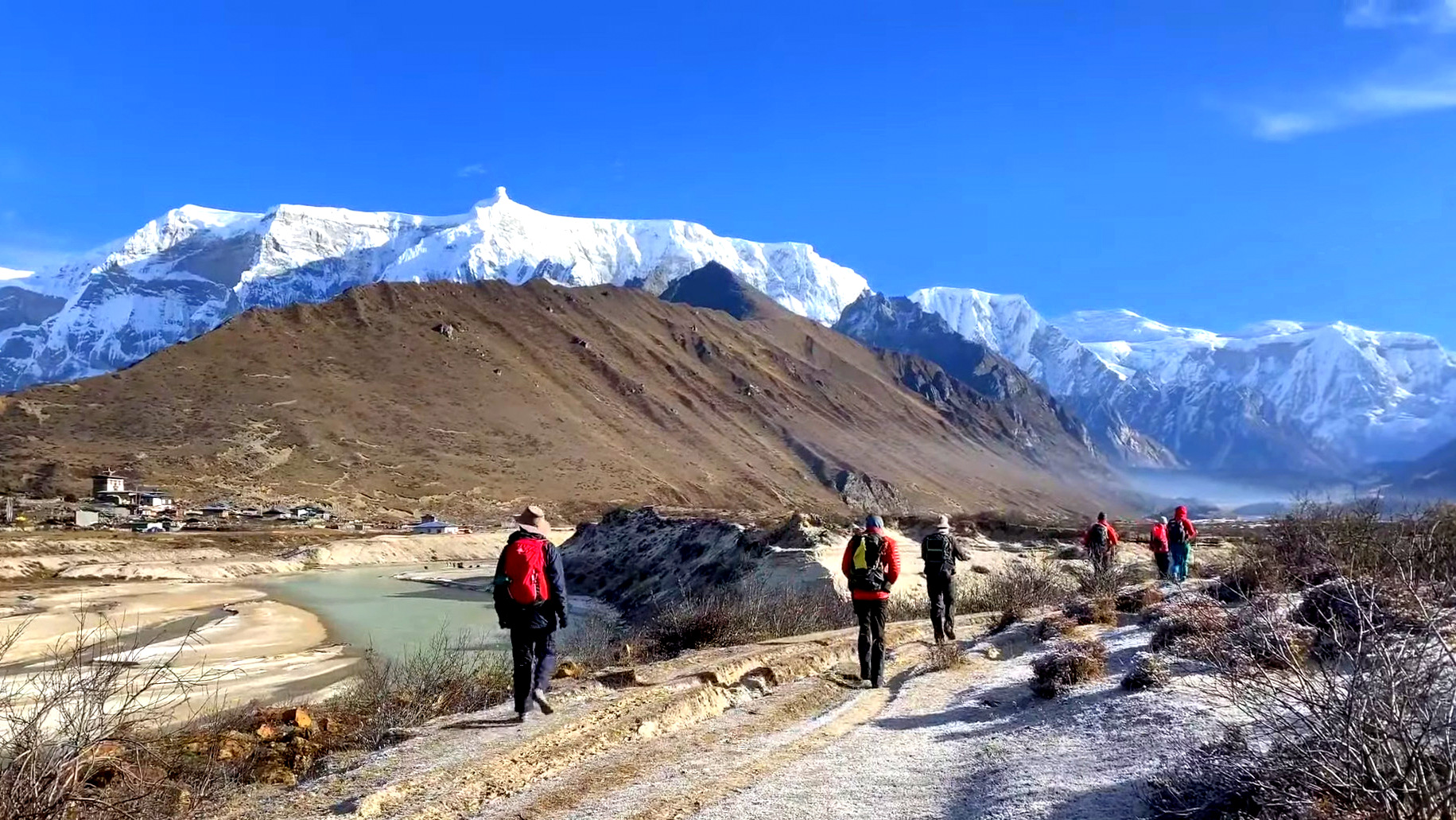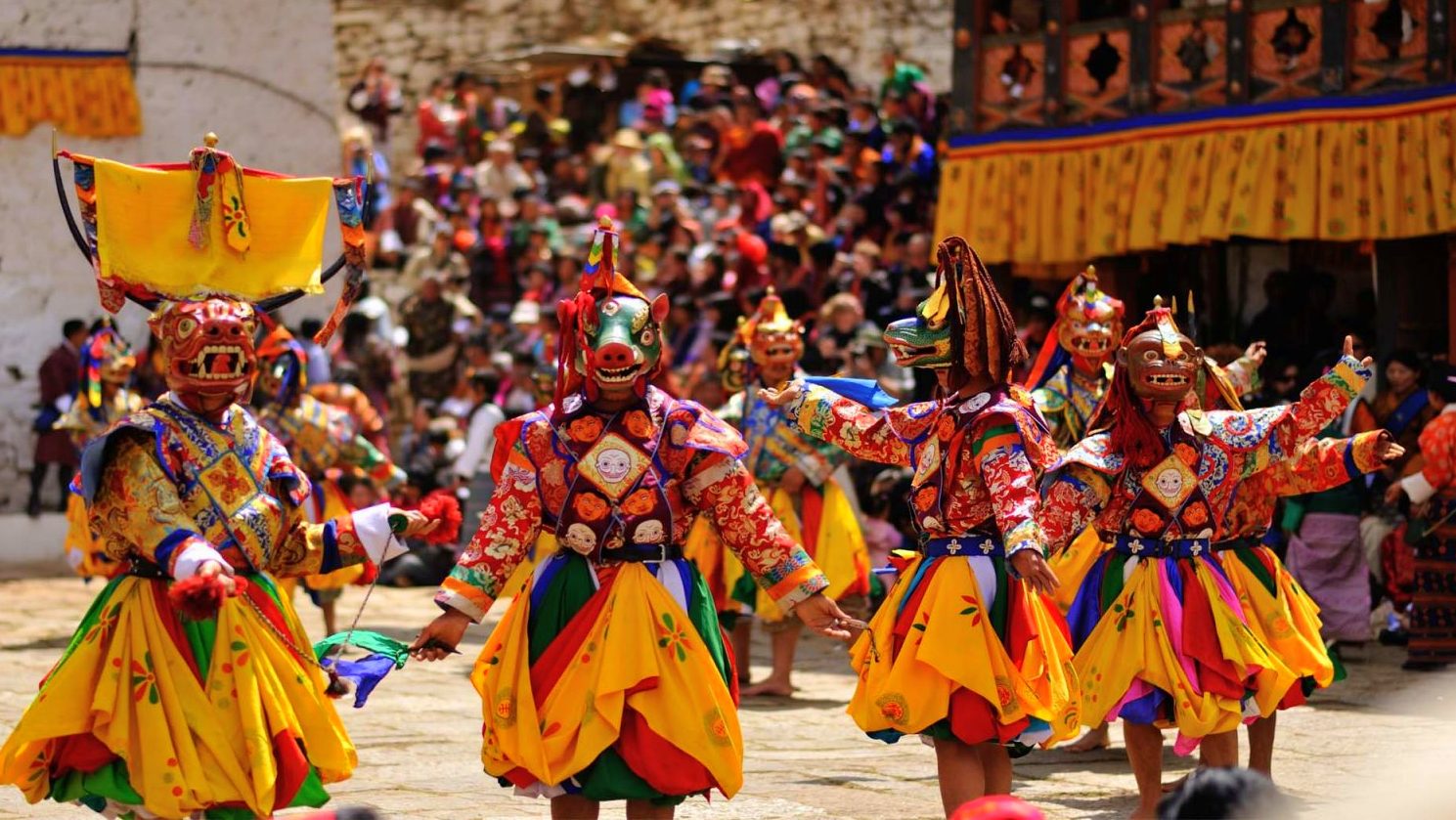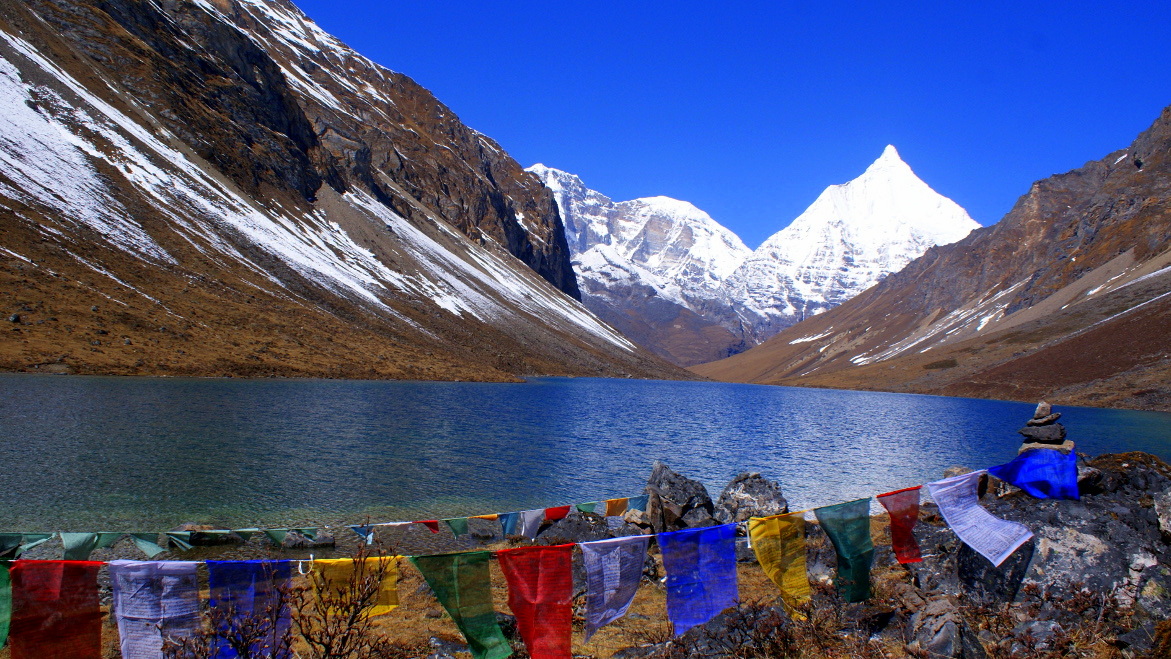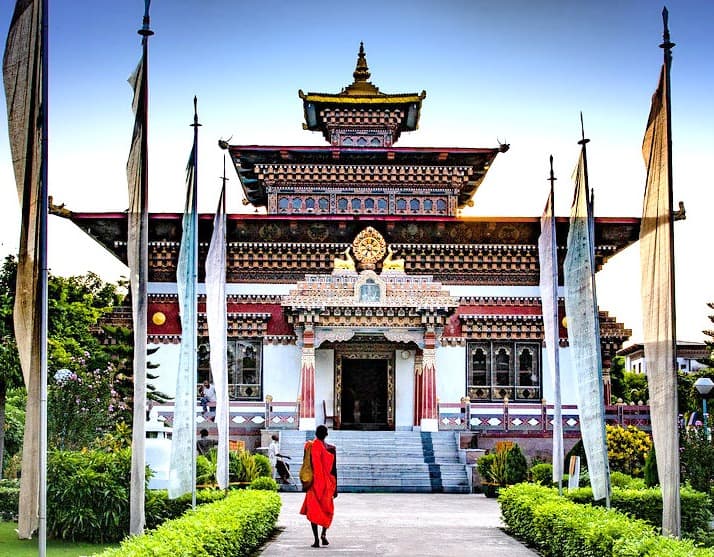- Accessibility and Diversity
- Natural Beauty and Conservation
- Safety and Support
- Cultural and Spiritual Experience
- Unique Bhutanese Hospitality
- Popular Trekking Destination
- Best Time to Trek in Bhutan
- Preparation and Permits to do Trekking in Bhutan
- FAQs of Trekking in Bhutan: Routes for the Beginners and Seasoned Hikers
Bhutan, a hidden jewel nestled in the heart of the Himalayas, is a sanctuary of tranquility, natural beauty, and spiritual heritage. Known as the Last Shangri-La, this mystical kingdom offers a unique blend of ancient traditions and breathtaking landscapes, making it a paradise for trekkers and cultural enthusiasts alike. With its pristine forests, majestic mountains, and serene monasteries, Bhutan's trekking destinations are unparalleled, offering routes that cater to both novice wanderers and adventurous spirits. From the lush valleys of the Bumthang Cultural Trek to the challenging heights of the Snowman Trek, Bhutan invites travelers to explore its untouched beauty, immerse in its rich culture, and embark on a journey of self-discovery amidst its tranquil and sacred mountains.

At Druk Holidays, we specialize in creating unforgettable trekking experiences across Bhutan for both beginners and seasoned hikers. Our expertly curated treks are designed to suit every level of fitness and interest, ensuring a memorable journey through Bhutan's stunning landscapes. With our experienced guides, comprehensive support, and deep understanding of Bhutan's culture and environment, Druk Holidays stands out as the go-to company for anyone looking to explore the beauty of trekking in this majestic country. Whether you're seeking a gentle introduction to the outdoors or a challenging adventure, we're here to make your trekking dream a reality.
Accessibility and Diversity
The Accessibility and Diversity of trekking in Bhutan are significant features that cater to a wide range of preferences and capabilities among trekkers. Here's a closer look at what these features entail:
Accessibility
- All Levels Welcome: Bhutan's trekking routes are designed to accommodate everyone from complete beginners to seasoned mountaineers. This ensures that regardless of your trekking experience or physical fitness, you can find a route that's just right for you.
- Well-Defined Trails: The trails are well-marked and maintained, reducing the risk of getting lost and making it easier for trekkers to navigate through the diverse terrains of Bhutan.
- Guided Expeditions: Every trekking group is led by experienced and knowledgeable local guides. This not only ensures safety but also enriches the trekking experience as the guides share insights about the local culture, history, and environment.
Diversity
- Varied Landscapes: Trekkers in Bhutan traverse through a wide array of landscapes, from lush valleys and dense forests to high mountain passes and serene lakes. This diversity in scenery ensures that every day on the trail brings something new and exciting.
- Cultural Experiences: The routes often pass through or near traditional villages, ancient monasteries, and sacred sites, offering trekkers a profound cultural immersion into the Bhutanese way of life.
- Seasonal Variations: Depending on the time of year you choose to trek, the landscapes of Bhutan offer different experiences, from blooming rhododendrons in the spring to clear, snow-capped mountain views in the winter.
These features make trekking in Bhutan not just an adventure through nature but a journey through a living culture and a thriving ecosystem. The combination of accessibility for all skill levels and the diversity of experiences available ensures that every trekker can find a route that fulfills their adventure and cultural curiosity.
Natural Beauty and Conservation
Bhutan's approach to Natural Beauty and Conservation is deeply rooted in its commitment to preserving its pristine environment and rich biodiversity. This commitment shapes a unique trekking experience that is as enriching as it is responsible. Here's how these aspects are integral to trekking in Bhutan:

Natural Beauty
- Untouched Landscapes: Bhutan's strict environmental policies have ensured that its forests, mountains, and rivers remain untouched and unspoiled by mass tourism. Trekkers are treated to breathtaking views of unspoiled natural beauty, from towering Himalayan peaks to dense, ancient forests.
- Diverse Ecosystems: The variety of altitudes and climates across Bhutan's trekking routes offers a chance to experience a wide range of ecosystems. From subtropical jungles in the south to temperate forests and alpine meadows higher up, the country is a haven for nature lovers.
- Floral and Faunal Richness: Bhutan is home to a wealth of biodiversity, including several endemic species. Trekkers might encounter rare flora like the blue poppy (Bhutan's national flower) and diverse fauna, including snow leopards, red pandas, and black-necked cranes, in their natural habitats.
Conservation
- Sustainable Practices: Bhutan is the world's only carbon-negative country, and this achievement is partly due to its sustainable approach to tourism and trekking. The use of wood for fires is regulated, waste management practices are strictly enforced, and the number of visitors is controlled to minimize environmental impact.
- Protected Areas: A significant portion of Bhutan is designated as protected areas, including national parks, wildlife sanctuaries, and nature reserves. These areas are carefully managed to ensure the preservation of their natural and cultural heritage, providing a sanctuary for wildlife and native plants.
- Community Involvement: Conservation efforts in Bhutan often involve local communities, who play an active role in protecting their environment. This community-based approach ensures that conservation benefits both nature and the local people, fostering a harmonious relationship between humans and their surroundings.
Through these measures, Bhutan offers a trekking experience that is not only visually stunning but also deeply respectful of nature and local cultures. Trekkers in Bhutan become part of this conservation ethos, contributing to the preservation of the country's natural beauty for future generations.
Safety and Support
Trekking in Bhutan is renowned not just for its breathtaking landscapes and cultural immersion but also for the high level of safety and support provided to trekkers. The Bhutanese government and local tour operators prioritize the well-being and security of all visitors, ensuring a safe environment for both beginners and seasoned hikers. Here are key aspects that contribute to the safety and support framework for trekking in Bhutan:
-
Licensed and Experienced Guides: All treks must be accompanied by licensed Bhutanese guides who are well-trained in first aid, knowledgeable about the local terrain, culture, and history, and experienced in navigating the trails. These guides are invaluable for their ability to manage emergencies, provide insights into the local environment, and enhance the overall trekking experience.
-
Regulated Tourism Industry: Bhutan's unique approach to tourism, focusing on sustainability and quality over quantity, means that trekking routes are not overcrowded, and the impact on the environment is minimized. The government's strict regulations and standards for tour operators ensure that all trekking expeditions are well-organized, with the safety of trekkers as a paramount concern.
-
Comprehensive Planning and Support: Trekking tours in Bhutan are meticulously planned, with itineraries that include detailed information on distances, altitudes, and expected conditions. Support teams, including porters and cooks, often accompany trekkers on more challenging routes, ensuring that basic needs are met so that trekkers can focus on the experience rather than logistics.
-
Emergency Preparedness: While Bhutan's remote terrain can pose challenges, tour operators are required to have emergency response plans in place. This includes communication equipment for remote areas and, when necessary, arrangements for evacuation. The relatively compact size of Bhutan and the efficiency of local services mean that help is never too far away.
-
Health and Acclimatization: Guides are trained to monitor trekkers for signs of altitude sickness and other health issues. Itineraries are designed to allow for proper acclimatization, reducing the risk of altitude sickness. Trekkers are encouraged to communicate any health concerns or needs to their guides, who are equipped to provide assistance or make adjustments to the plan as needed.
-
Infrastructure and Local Support: Bhutan’s trekking infrastructure, including designated campsites and lodges on some trails, is designed to support the needs of trekkers. Local communities are often involved in supporting treks, providing an additional layer of safety and a chance to experience Bhutanese hospitality.
-
Travel Insurance: While not mandatory, it is highly recommended that trekkers have comprehensive travel insurance that covers high-altitude trekking, medical evacuation, and other potential risks. This ensures that trekkers have access to the best possible care in the unlikely event of an emergency.
The combination of professional guide services, regulated tourism practices, and comprehensive support infrastructure ensures that trekking in Bhutan is not only an enriching experience but also a safe one. Whether navigating through the serene landscapes or exploring the ancient trails, trekkers can feel secure in the knowledge that they are well-supported throughout their journey.
Cultural and Spiritual Experience
Trekking in Bhutan transcends the physical journey, offering a profound Cultural and Spiritual Experience that deeply impacts trekkers. This unique aspect of Bhutanese treks stems from the country's rich heritage, spiritual traditions, and the Bhutanese people's way of life, which is deeply intertwined with Buddhism. Here’s how these experiences manifest during treks:

Cultural Immersion
- Traditional Villages: Many trekking routes in Bhutan wind through remote villages where life has remained unchanged for centuries. Trekkers have the opportunity to witness daily rural life, interact with local communities, and learn about traditional Bhutanese practices, from agriculture to ancient crafts.
- Architectural Wonders: Bhutan is renowned for its stunning dzongs (fortresses), monasteries, and temples that often date back to the 7th century. These structures are not just architectural marvels but are active centers of religious life, offering insights into the spiritual practices that shape the country.
- Festivals: Timing a trek to coincide with local tshechus (religious festivals) can offer a vibrant glimpse into Bhutanese culture. These festivals feature colorful mask dances, traditional music, and rituals that are believed to confer blessings upon the spectators.
Spiritual Experience
- Buddhist Practices: The trekking paths often lead to sacred sites steeped in Buddhist mythology and history, such as Taktsang Monastery (Tiger’s Nest) perched on a cliffside. Visiting these sites provides a unique insight into the spiritual practices and beliefs that are central to Bhutanese life.
- Meditative Landscapes: The natural beauty of Bhutan’s landscapes, from serene valleys to majestic mountain ranges, offers a perfect backdrop for reflection and meditation. The peaceful environment encourages a sense of inner calm and mindfulness, enhancing the spiritual aspect of the trek.
- Spiritual Guides: Many treks are led by guides who are not only knowledgeable about the terrain but also about the spiritual significance of the places visited. Their insights can deepen the understanding and appreciation of Bhutan’s spiritual heritage.
Ethical Travel
- Preservation of Culture: The Bhutanese government and local communities are deeply committed to preserving their cultural heritage. Trekkers are encouraged to respect local customs and traditions, contributing to the sustainable preservation of the unique culture.
- Supporting Local Economies: Engaging with local services, such as homestays, guides, and artisans, supports the local economy and promotes cultural exchange, making trekking in Bhutan a mutually enriching experience for both visitors and hosts.
The blend of cultural richness and spiritual depth ensures that trekking in Bhutan is more than just a physical challenge; it’s a journey that nourishes the soul, broadens the mind, and leaves trekkers with a lasting sense of connection to this unique Himalayan kingdom.
Unique Bhutanese Hospitality
The Unique Bhutanese Hospitality is a hallmark of the trekking experience in Bhutan, making it a truly unforgettable journey for every visitor. This distinctive hospitality is deeply rooted in the country's cultural ethos of kindness, respect, and community spirit. Here's how Bhutanese hospitality stands out and enriches the trekking experience:
Warm Welcomes
- Personalized Attention: In Bhutan, hospitality is personalized, making visitors feel genuinely welcomed and cared for. Whether it's in a local homestay, a lodge, or even on the trails, the Bhutanese go out of their way to ensure guests are comfortable and their needs are met.
- Cultural Exchange: Interaction with local hosts often leads to meaningful cultural exchanges. Guests might find themselves invited to participate in local traditions, ceremonies, or even daily chores, offering a deeper understanding and appreciation of Bhutanese life.
Authentic Homestays
- Staying with Local Families: Many trekking routes offer the option of staying in homestays, where trekkers can live with Bhutanese families. This provides an intimate glimpse into the authentic Bhutanese way of life, from cuisine to family dynamics and traditional practices.
- Traditional Bhutanese Cuisine: Hospitality extends to the dining table, where guests are treated to homemade traditional dishes prepared with fresh, local ingredients. Meals often become a highlight of the visit, showcasing the diversity and richness of Bhutanese cuisine.
Sustainable and Responsible Tourism
- Community Involvement: Bhutanese hospitality is also about inclusivity and sustainability. The involvement of local communities in tourism ensures that the benefits are shared, promoting sustainable development and conservation efforts.
- Environmental Consciousness: Guests are often impressed by the Bhutanese commitment to environmental preservation, which is integrated into their hospitality practices. From eco-friendly lodges to organic farming practices used in preparing meals, every aspect of hospitality reflects a deep respect for nature.
Spirit of Generosity
- Generosity and Openness: The Bhutanese are known for their spirit of generosity and openness. Visitors often recount stories of unexpected kindnesses, from guides sharing personal insights into Bhutanese philosophy to families opening their homes and hearts to strangers.
- Guidance and Care: Throughout the trekking experience, the guidance and care provided by Bhutanese hosts and guides ensure that every visitor feels safe, respected, and valued. This level of care extends beyond mere professional obligation, reflecting a genuine desire to share Bhutan's beauty and culture with the world.
Bhutanese hospitality, with its deep cultural roots and commitment to sustainable, responsible tourism, offers trekkers a uniquely heartwarming experience. It's an integral part of what makes trekking in Bhutan so special, leaving visitors with lasting memories of not just the stunning landscapes but the warmth and kindness of the Bhutanese people.
Popular Trekking Destination
Bhutan, with its majestic Himalayan landscapes and rich cultural heritage, offers a range of trekking destinations that cater to both beginners and seasoned hikers. Among these, some have gained popularity due to their breathtaking beauty, cultural significance, and unique challenges. Here are some of the most popular trekking destinations in Bhutan:

Jomolhari Trek
- Level: Moderate to Difficult
- Duration: 7-9 days
- Highlights: This trek offers stunning views of Mount Jomolhari at 7,326 meters, the second highest peak in Bhutan. The route passes through diverse landscapes, including rhododendron forests, alpine meadows, and high mountain passes. Trekkers also get to experience remote villages and ancient fortresses along the way.
Druk Path Trek
- Level: Moderate
- Duration: 5-6 days
- Highlights: The Druk Path Trek is known for its scenic beauty and cultural insights, connecting the valleys of Paro and Thimphu. It features beautiful high-altitude lakes, spectacular mountain views, and the chance to visit ancient lhakhangs (temples) and dzongs (fortresses). It's ideal for those looking to combine moderate trekking with cultural exploration.
Snowman Trek
- Level: Very Difficult
- Duration: 25-30 days
- Highlights: Considered one of the world's toughest treks, the Snowman Trek traverses through some of Bhutan's most remote areas, offering unparalleled views of the Himalayas. It crosses numerous high passes above 5,000 meters, making it a challenge even for the most experienced trekkers. The trek provides a rare glimpse into the life of nomadic yak herders and untouched natural beauty.
Bumthang Cultural Trek
- Level: Easy to Moderate
- Duration: 3-4 days
- Highlights: This trek is less about high-altitude challenges and more about immersing in Bhutan's rich cultural heritage. It passes through several important Buddhist sites and monasteries, offering insights into the spiritual life of the country. The gentle trails through Bumthang's beautiful valleys make it accessible to beginners and those interested in cultural experiences.
Dagala Thousand Lakes Trek
- Level: Moderate
- Duration: 6-7 days
- Highlights: As the name suggests, this trek is famous for its stunning high-altitude lakes. Along with breathtaking views of the entire Himalayan range and Mount Everest, trekkers can enjoy fishing in the clear mountain lakes. The route also offers the chance to spot various species of birds and flowers, making it a nature lover's paradise.
Laya Gasa Trek
- Level: Difficult
- Duration: 14-16 days
- Highlights: This trek takes adventurers through some of Bhutan's most picturesque landscapes, including the Laya region, home to the indigenous Layap people. It offers a mix of cultural interaction and natural beauty, with hot springs, beautiful campsites, and the chance to see the legendary Takin, Bhutan's national animal.
Each of these destinations offers a unique blend of natural beauty, cultural richness, and physical challenge, making Bhutan a premier trekking destination for adventurers from around the globe. Whether you seek the solitude of remote mountain paths or the warmth of Bhutanese hospitality, these treks promise an unforgettable journey through the heart of the Himalayas.
Best Time to Trek in Bhutan
Choosing the best time to trek in Bhutan is crucial for maximizing the enjoyment and success of your hiking experience. Bhutan’s unique geographical features and elevation variations mean that the country experiences a wide range of climates, impacting trekking conditions. Generally, the optimal periods for trekking are during the spring and autumn seasons, each offering distinct advantages.
Spring (March to May)
Spring in Bhutan is characterized by warm days, cool nights, and gradually diminishing snow at higher altitudes, making it one of the most popular times for trekking. This season provides trekkers with several key benefits:
- Blooming Flora: Spring sees the Himalayan landscape come alive with blooming rhododendrons and other wildflowers, adding vibrant colors to the trails and making this period particularly scenic.
- Stable Weather: The weather during spring is generally stable and dry, offering clear skies and excellent visibility, which is perfect for enjoying panoramic views of the mountains.
- Moderate Temperatures: Although the weather can be variable, temperatures are usually comfortable for trekking, neither too hot in the lower elevations nor too cold in the higher altitudes.
Autumn (September to November)
Autumn is another prime trekking season in Bhutan, favored for its clear skies and the post-monsoon freshness in the air. The advantages of trekking in autumn include:
- Clear Mountain Views: With the monsoon rains having cleared the air of dust and haze, autumn provides some of the clearest views of Bhutan’s majestic peaks, including the famous Jomolhari and Gangkar Puensum.
- Stable and Cool Weather: The weather is stable, with little rainfall, and the temperatures are cool, ideal for long treks. Nights can be chilly at higher elevations, but the days are comfortably warm.
- Cultural Festivals: Autumn coincides with several of Bhutan’s colorful festivals, such as the Thimphu Tshechu and Paro Tshechu. Trekkers can plan their trips to coincide with these festivals, offering a wonderful opportunity to experience Bhutanese culture up close.
Considerations for Other Seasons
- Summer (June to August): The monsoon season, characterized by heavy rains and potential leeches on lower altitude treks. However, some sheltered valleys in the north can still be viable for trekking.
- Winter (December to February): Cold weather with snow at higher altitudes can make many treks inaccessible. However, lower altitude treks can be quite pleasant, with fewer tourists and clear skies.
The best time to trek in Bhutan largely depends on what you wish to experience. For clear skies, stable weather, and cultural immersions, spring and autumn are unbeatable. However, those willing to brave the colder temperatures or the monsoon's unpredictability can find unique charms and fewer crowds in the winter and summer months, respectively. Regardless of when you choose to go, Bhutan’s trails offer an unforgettable trekking experience, blending natural beauty, cultural richness, and spiritual serenity.
Preparation and Permits to do Trekking in Bhutan
Trekking in Bhutan is an adventure that requires careful planning and preparation, not only in terms of physical readiness but also in understanding and adhering to the country’s regulations on travel and trekking permits. Here's a guide to help you prepare for your trekking expedition in Bhutan:
Preparation
-
Physical Fitness: Depending on the difficulty level of the trek you choose, it’s crucial to be in good physical condition. Start a fitness regime months in advance, focusing on cardio, strength training, and hikes to build endurance and acclimate your body to long walks, especially if you plan to embark on high-altitude treks.
-
Gear and Clothing: Invest in high-quality trekking gear and clothing suitable for varying weather conditions. Essential items include a sturdy pair of hiking boots, a waterproof jacket, thermal layers, trekking poles, a sleeping bag rated for cold temperatures, and a comfortable backpack. Don’t forget sun protection and possibly altitude sickness medication.
-
Research and Planning: Familiarize yourself with the trekking route, its challenges, expected weather conditions, and the cultural norms of the areas you will visit. Planning your trek with a reputable trekking company can provide valuable insights and support for a safe and enjoyable experience.
Permits and Regulations
-
Tourist Visa: All international tourists (except citizens of India, Bangladesh, and the Maldives) need to obtain a visa to enter Bhutan. The visa process is typically handled by your tour operator and approved by the Tourism Council of Bhutan once the full tour payment is received. The visa fee is USD 40.
-
Trekking Permits: In addition to a visa, trekkers need to obtain specific permits for trekking, especially for routes that venture into protected or restricted areas. These permits are arranged by your tour operator as part of the trekking package.
-
Minimum Daily Package: Bhutan has a unique tourism policy that requires international tourists to pay a minimum daily package rate. This rate includes accommodation, transportation, a guide, food, and entry fees but varies depending on the season (USD 200-250 per person per night). A portion of this fee is used for free education, healthcare, and poverty alleviation in Bhutan.
-
Travel Insurance: While not a mandatory requirement, it’s highly recommended to have comprehensive travel insurance that covers high-altitude trekking, medical evacuation, and any unforeseen circumstances that might occur during your trek.
-
Booking through a Local Agency: All international tourists must book their trip through a Bhutanese tour operator or one of their international partners. This includes trekking expeditions, which are meticulously planned and guided by experienced locals familiar with the terrain and regulations.
-
Sustainable Travel: Bhutan emphasizes sustainable and responsible tourism. Trekkers are expected to respect the environment, local customs, and cultural sites. This includes following the principles of Leave No Trace, ensuring that the pristine nature of Bhutan is preserved for future generations.
By taking these preparation steps and adhering to Bhutan’s permit and regulation requirements, trekkers can ensure a memorable and impactful journey through one of the world’s most beautiful and culturally rich trekking destinations.
Trekking in Bhutan offers an unparalleled adventure that blends the physical challenge of navigating through some of the world's most breathtaking landscapes with the spiritual and cultural enrichment of immersing oneself in the kingdom's ancient traditions. Whether you're a beginner drawn to the allure of Bhutan's mystical valleys and cultural treks or a seasoned hiker ready to conquer the high-altitude trails of the Himalayas, Bhutan caters to every level of trekker with its diverse routes. Preparation and respect for the country's regulations and environment are key to ensuring a memorable and sustainable journey. As you embark on this extraordinary trekking experience, the beauty of Bhutan's natural landscapes, the warmth of its people, and the depth of its culture promise to leave an indelible mark on your heart, making it not just a journey through the mountains, but a journey of personal discovery and connection.
FAQs of Trekking in Bhutan: Routes for the Beginners and Seasoned Hikers
Q. What is the best time of year to go trekking in Bhutan?
A. The best times for trekking in Bhutan are during the spring (March to May) and autumn (September to November) seasons. During these months, the weather is generally stable, and the skies are clear, offering spectacular views of the Himalayan peaks.
Q. Do I need a guide to trek in Bhutan?
A. Yes, all tourists (except citizens of India, Bangladesh, and the Maldives) are required to have a licensed Bhutanese tour guide accompany them during their trek. This is part of Bhutan's policy to ensure the safety of travelers and the sustainability of tourism.
Q. How difficult are the treks in Bhutan?
A. Bhutan offers a wide range of treks, from easy cultural treks suitable for beginners to challenging high-altitude treks for seasoned hikers. The difficulty level depends on the specific trek, its altitude, terrain, and duration.
Q. What are the visa and permit requirements for trekking in Bhutan?
A. All international tourists need a visa to enter Bhutan, arranged through a registered tour operator, along with a trekking permit for certain areas. The cost of the visa is USD 40, and permits are typically included in the trekking package arranged by your tour operator.
Q. How much does trekking in Bhutan cost?
A. The cost of trekking in Bhutan includes the minimum daily package rate set by the Bhutanese government, which ranges from USD 200-250 per person per night, depending on the season. This rate covers accommodation, meals, a licensed guide, transportation, and entry fees. Trekking costs may vary based on the trek's duration and difficulty.
Q. What should I pack for a trek in Bhutan?
A. Essential items include sturdy hiking boots, weather-appropriate clothing (layers for cold and waterproof gear), a comfortable backpack, a sleeping bag, personal medications, sun protection, and possibly altitude sickness medication. Your tour operator can provide a detailed packing list.
Q. Are there any health considerations I should be aware of before trekking in Bhutan?
A. Visitors should be in good physical health, particularly for high-altitude treks. It's advisable to consult with a doctor regarding vaccinations and altitude sickness medication. Staying hydrated and acclimatizing to higher elevations gradually can help prevent altitude sickness.
Q. Can I customize my trekking route in Bhutan?
A. Yes, many tour operators offer customizable trekking packages. You can work with them to tailor a trek that matches your interests, fitness level, and desired duration, incorporating cultural sites or specific regions you wish to explore.
Q. What measures are in place for safety and emergencies during treks?
A. Reputable tour operators have safety measures and emergency response plans in place, including experienced guides trained in first aid. For remote and high-altitude treks, arrangements for emergency evacuation, if necessary, are typically part of the planning process.
Q. How does trekking in Bhutan contribute to sustainable tourism?
A. The minimum daily package rate includes a sustainable development fee used to fund free education, healthcare, and environmental conservation projects in Bhutan. By trekking in Bhutan, visitors contribute to the country's commitment to sustainable and responsible tourism.



